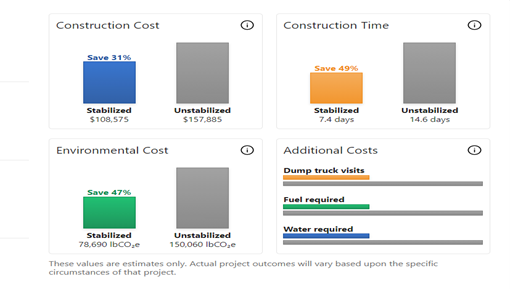Supporting Sustainability Initiatives with 'Cradle to Grave' EPDs
by Dan Winkle, on February 09, 2023
 In order to create a more resilient future, we need infrastructure that optimizes construction efficiencies and performance, while minimizing environmental impact. An assessment of environmental impact is becoming a more common design criterion in a growing number of jurisdictions around the world. One of the tools created for this purpose is the Environmental Product Declaration (EPD). The use of EPDs to assess environmental impacts such as Global Warming Potential (GWP) is expanding rapidly in the construction industry.
In order to create a more resilient future, we need infrastructure that optimizes construction efficiencies and performance, while minimizing environmental impact. An assessment of environmental impact is becoming a more common design criterion in a growing number of jurisdictions around the world. One of the tools created for this purpose is the Environmental Product Declaration (EPD). The use of EPDs to assess environmental impacts such as Global Warming Potential (GWP) is expanding rapidly in the construction industry.
EPDs enable the assessment of the environmental performance of products based on a Life Cycle Assessment (LCA). An EPD communicates verifiable, accurate, non-misleading environmental information for products and their applications. Based on the requirements of international standards, EPDs support scientifically based choices and stimulate the potential for market-driven environmental improvements.
How can EPDs be used?
There are a number of uses for EPDs: they can provide key information covering all aspects of a product from the beginning of the design process through to the end of its life cycle.
- Procurement – EPDs provide purchasers with confidence that products have been independently assessed and quantified for their environmental impact.
- Design – information from EPDs will feed into the design process and enable the designer to design for minimal whole-life environmental impact of a project.
- Specification – Specifiers can include environmental impact limits as part of their project specifications.
- Product comparison – environmental impact values obtained from product EPDs can be used alongside quantified performance levels when comparing solutions.
- Manufacturing and logistics – by giving transparency to the environmental cost of each aspect of a product’s life cycle, manufacturing and logistics teams can identify the beneficial impact of any improvements made, supporting a program of continual improvement.
Commitment to Environmental Stewardship
Tensar has a long-standing commitment to environmental stewardship. Our wide range of solutions helps meet this challenge by reducing the material required to stabilize land and deliver more durable infrastructure. Tensar solutions provide measurable reductions in the global warming potential and reduction of embodied carbon helping our customers meet sustainability goals through:
- Reducing excavation of soil and rock materials needed during construction and enabling use of varying local fills, thereby minimizing land disturbance, reducing hauling, and accelerating construction.
- Reducing the amount of high carbon-emitting materials such as asphalt.
- Allowing the use of recycled and reclaimed materials such as recycled concrete and reclaimed asphalt pavement in site construction.
As part of our innovative commitment to decarbonize infrastructure, Tensar also looks for ways to reduce the environmental impact of our products and operations. As part of this commitment, Tensar has recently completed EPDs on a variety of product solutions.
Tensar EPDs: from 'cradle to grave' sustainability
Tensar publishes ‘cradle to grave’ EPDs for the full range of Tensar InterAx and TriAx stabilization geogrids. This means that the environmental impacts are assessed for the whole life of the product and beyond that to recycling or disposal.
What is a 'cradle to grave' assessment?
Some EPD’s cover only the stages of manufacture but to comply with EN ISO 15804-A2, the 'cradle to grave' assessment must cover the full life cycle of a product, from manufacture through installation and use, followed by removal and disposal or recycling. The life cycle assessment (LCA) is broken down into stages with modules to assess every stage using common rules.
- Extraction and processing of Raw materials
- Manufacturing
- Transportation and distribution
- Use, reuse, and maintenance
- Recycling and final disposal

Environmental Impacts Assessed in an EPD
Environmental impact assessment involves much more than counting tonnes of carbon. The EPD assessment is extensive and detailed, covering multiple environmental aspects. Some of the core parameters are listed below:
- Depletion of physical resources
- Minerals
- Fossil fuels
- Impact on marine and water resources
- Impact on soils and land use
- Global warming potential
- Biogenic
- Fossil
- Land use and change
- Ozone layer depletion
- Human toxicity
- Particulate matte
Tensar’s Environmental Product Declarations are an important tool that provides transparent data about the environmental sustainability of our products. Using EPD data, Tensar has developed a carbon calculator that quantifies the environmental benefits when utilizing Tensar solutions. The carbon calculator is included in the free, award-winning web-based tool Tensar+™ design software available at https://www.tensarplus.com/.

Tensar’s EPD and tools like Tensar+ design software allow stakeholders to make more informed decisions by helping to develop more resilient and sustainable infrastructure that safeguards the foundation of local and global communities today and in the future.
To learn more about EPDs, join us for our on-demand webinar "Intro to Environmental Product Declarations and Their Use in Construction." We discuss the use of EPDs to properly assess projects over their entire life cycle and the assumptions and limitations which affect these analyses.
If you would like to understand how Tensar geogrids can improve your project sustainability credentials, please visit our environmental product declarations page.




